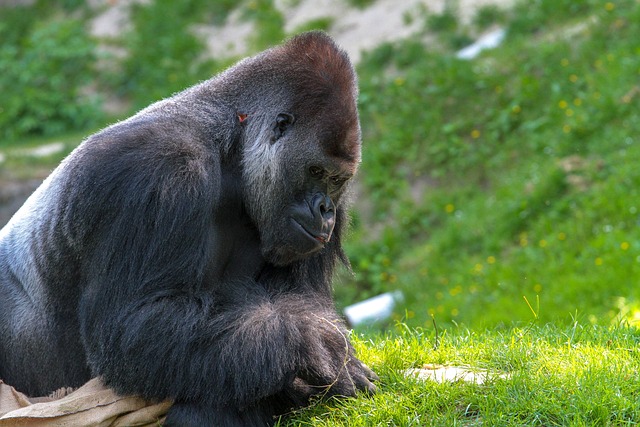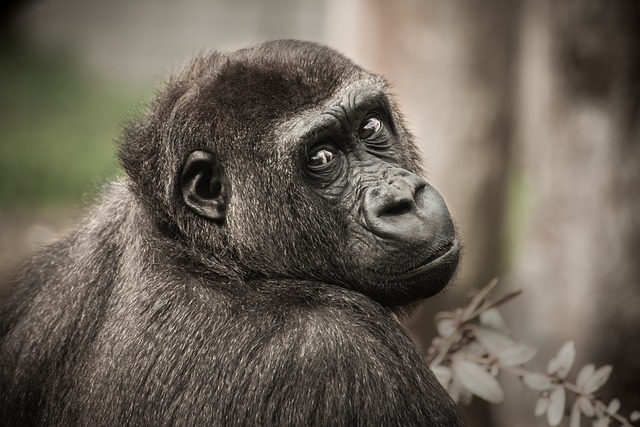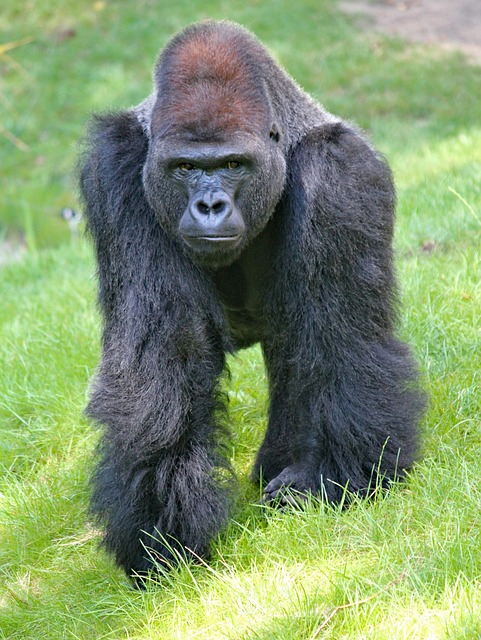Gorillas have captivated our attention and fascination for centuries with their impressive size, strength, and intelligence. As one of the closest living relatives to humans, these gentle giants have a significant role in the animal kingdom.
In this comprehensive guide, we will delve into the world of gorillas, covering their evolution, habitat, behavior, reproduction, and the threats they face in the wild.
Our goal is to provide you with a better understanding of these magnificent creatures and their importance in the ecosystem.
So, let's embark on a journey to discover the fascinating world of gorillas and gain a deeper appreciation for these incredible creatures.

Evolution and Classification of Gorillas
Gorillas are one of the most fascinating and intelligent creatures in the animal kingdom. They are classified as members of the great ape family, along with chimpanzees, orangutans, and humans. Their evolutionary journey can be traced back millions of years, making them one of the oldest living species on Earth. In this section, we will explore the evolution and classification of gorillas, their physical characteristics, and the different types of gorillas found in the wild.
Evolution:
The evolution of gorillas can be traced back to approximately 8 million years ago, where they shared a common ancestor with humans. As they branched off into their own evolutionary line, gorillas continued to evolve and adapt to their environment. They are believed to have originated from Africa and have undergone various physical and behavioral changes throughout their evolutionary journey.
Classification:
Gorillas are classified into two species: the Eastern Gorilla (G. beringei) and the Western Gorilla (G. gorilla). Within these two species, there are four sub-species: the Mountain Gorilla, Eastern Lowland Gorilla, Western Lowland Gorilla, and Cross River Gorilla. Each sub-species has its own unique physical characteristics and distribution in the wild.
Physical Characteristics:
Gorillas are known for their massive size and strength, with males weighing up to 400 pounds and standing at a height of 6 feet. They have distinctive features, including a broad chest, muscular arms, and a robust jaw. Gorillas have dark brown or black hair covering their entire body, except for their face, hands, and feet. Interestingly, their nose and ear shapes are unique to each individual, much like human fingerprints.
Types of Gorillas:
The Mountain Gorilla is the largest of all gorilla species and is found in the mountainous regions of Central Africa. The Eastern and Western Lowland Gorillas are slightly smaller and are found in the lowland rainforests of Central and Western Africa, respectively. The Cross River Gorilla is the rarest of all gorilla sub-species and is found in a small area between Nigeria and Cameroon.
Geographical Distribution:
Gorillas are primarily found in the tropical and sub-tropical forests of Central and Western Africa. Their distribution is limited to the equatorial regions, as they require a specific type of environment to thrive. They are found in a variety of habitats, including dense rainforests, swamps, and bamboo forests.
Habitat and Diet of Gorillas
The habitat and diet of gorillas are closely intertwined and play a crucial role in their survival and well-being. Gorillas are found in the tropical and subtropical forests of Central and Western Africa, with their geographical range spanning across countries such as Cameroon, Gabon, Congo, and Uganda. They primarily inhabit dense, lowland rainforests, but can also be found in mountainous regions and bamboo forests.
Gorillas are herbivorous animals, which means their diet consists mainly of plants. In fact, they are the largest primates that primarily feed on vegetation. Their diet is primarily composed of leaves, fruits, seeds, and stems, with some species also consuming insects and small animals on occasion. Gorillas have a diverse palate and can feed on up to 100 different plant species in their habitat. This allows them to have a varied and nutrient-rich diet.
Their habitat plays a critical role in determining the availability and variety of food for gorillas. The forest provides a constant supply of edible plants and fruits, ensuring that gorillas have access to food throughout the year. The dense vegetation also provides ample opportunities for gorillas to forage and search for food, which is crucial for their survival.
Furthermore, the forest also offers protection and shelter for gorillas, allowing them to thrive and flourish. The dense canopy cover protects them from extreme weather conditions, and the thick undergrowth provides them with hiding places and resting spots. This is particularly important for gorillas as they have limited natural defenses against predators.
As mentioned earlier, gorillas are herbivorous animals, but their diet may vary depending on their location and availability of food. For example, in the lowland forests of Central Africa, western lowland gorillas primarily feed on fruits and leaves, while mountain gorillas in the high-altitude rainforests of Uganda and Rwanda have a diet that is richer in stems and piths. This is because of the differences in vegetation in their respective habitats.
Gorillas have a slow and deliberate feeding style, often spending hours foraging for food and carefully selecting leaves and fruits to eat. This is because their digestive system is not designed to process large quantities of food, and they need to carefully choose their meals to meet their nutritional requirements.
In addition to their diet, gorillas also rely on the forest for their water needs. They obtain most of their water from the food they eat, but also drink from streams and water bodies within their habitat. The forest's water sources also provide a place for social interactions among gorillas and serve as a vital resource for their overall well-being.

Social Behavior and Communication of Gorillas
Gorillas are highly social and intelligent animals, living in cohesive groups known as troops or bands, led by a dominant male called the silverback. These groups typically consist of 5 to 30 individuals, including females, their offspring, and a few younger males. In this section, we will delve deeper into the social behavior and communication methods of these fascinating creatures.
Social Structure:
Gorillas have a complex social structure, with each individual having a specific role within the group. The silverback is the leader and protector of the group, responsible for making important decisions and defending the troop against potential threats. The females, who are usually related to the silverback, play a crucial role in the group as caregivers and educators for the young gorillas. The younger males, also known as blackbacks, serve as protectors and potential future leaders of the group. This social structure ensures the survival and well-being of the entire troop.
Communication Methods:
Gorillas use a variety of communication methods to interact with each other, including vocalizations, facial expressions, and body postures. Their vocalizations range from grunts and roars to hoots and barks, which can relay information about their location, mood, and intentions. They also use facial expressions, such as baring their teeth or making eye contact, to convey dominance or submission. Body postures, such as standing upright or beating their chests, are also used for intimidation or as a display of strength.
One of the most intriguing aspects of gorilla communication is their use of gestures. They have been observed using different hand movements, such as arm swings, head nods, and hand claps, to communicate with each other. These gestures can have multiple meanings, depending on the context and the individual gorilla using them. For example, a head nod may signal a greeting or a warning, while a hand clap may indicate playfulness or aggression.
Importance of Social Bonds:
The social bonds and relationships within a gorilla troop are crucial for their survival and well-being. These bonds are formed through grooming, a behavior where gorillas use their hands to pick through each other's fur, removing dirt and parasites. This not only helps to maintain good hygiene but also strengthens their social bonds. Grooming also serves as a form of communication, where gorillas can convey affection, trust, and respect for one another.
Furthermore, gorillas also engage in other social behaviors, such as playing, cuddling, and sharing food. These activities not only strengthen their relationships but also promote a sense of unity and cooperation within the group.
Intraspecific Communication:
Apart from communicating with each other, gorillas also use different methods to communicate within their species. This is especially important during interactions with other gorilla troops, where they may need to convey dominance or submission. Gorillas use vocalizations, facial expressions, and gestures to communicate with members of other troops, and these signals are often understood by both groups.
Reproduction and Offspring of Gorillas
Gorillas are fascinating creatures that have captured the hearts of many with their intelligence, strength, and family bonds. In this section, we will delve into the reproductive cycle of gorillas and the unique characteristics of their offspring. We will also discuss the challenges and threats faced by gorilla populations in terms of reproduction and survival of their young.
The reproductive cycle of gorillas is similar to that of humans, with females experiencing a monthly menstrual cycle. However, unlike humans, gorillas can only reproduce during a specific time of the year. This is known as the breeding season, which typically occurs from late spring to early summer. During this time, females become sexually receptive, and males compete for the attention of potential mates.
The concept of silverback males plays a crucial role in the reproductive process of gorillas. These are the dominant males in a gorilla troop, and they are responsible for protecting and leading the group. Only the silverback male is allowed to mate with the females, and he ensures that no other males try to challenge his position. The females, on the other hand, will actively seek out the dominant male and show their interest through flirting behaviors.
Once a female becomes pregnant, the gestation period for gorillas is approximately 8.5 months. The mother will give birth to a single offspring, and it is during this time that the troop will show their support and care for the newborn. Gorilla infants are helpless at birth and are completely dependent on their mothers for survival. The bond between mother and infant is strong, with the mother providing care and protection for her young. She will carry the infant on her belly for the first few months, and then on her back until they are about three years old.
The development of gorilla offspring is divided into different stages, with each stage having unique physical and behavioral milestones. The first year of a gorilla's life is known as the infancy stage, where the infant grows and learns essential skills such as crawling, walking, and climbing. The next stage is the juvenile phase, which lasts from 2-4 years old. At this stage, the young gorilla is more independent and will start to explore their surroundings. The final stage is adolescence, which lasts from 4-6 years old. During this time, the young gorilla will mature and develop into an adult.
Unfortunately, gorilla populations face many challenges when it comes to reproduction and survival of their offspring. One of the biggest threats is poaching, where gorilla infants are often taken from their mothers and sold into the illegal pet trade. This not only disrupts the family structure but also reduces the chances of the infant's survival. Habitat loss and human encroachment also play a significant role in the decline of gorilla populations, as it limits their access to food and resources, making it harder for mothers to provide for their young.
Thankfully, there are many conservation efforts in place to protect gorillas and their offspring. One such initiative is the creation of protected areas to ensure their natural habitats are preserved. In addition, organizations work tirelessly to educate local communities about the importance of conservation and provide alternative sources of income to discourage poaching. As a result of these efforts, some gorilla populations have shown signs of recovery, giving hope for the future of these magnificent creatures.

Threats and Conservation Efforts for Gorillas
Gorillas, one of our closest relatives in the animal kingdom, are facing numerous threats that are putting their survival at risk. These majestic creatures are native to central and western Africa, and their habitats are being threatened by human activities such as deforestation, poaching, and diseases. As a result, gorilla populations are declining at an alarming rate, making it crucial for conservation efforts to be implemented to protect these unique and intelligent animals.
One of the main threats to gorillas is habitat loss. Deforestation, primarily for agriculture and logging, has significantly reduced the available habitats for gorillas. This not only leads to the direct loss of their homes but also disrupts their food sources and natural behaviors. As their habitats become fragmented, gorillas are also at risk of isolation and inbreeding, which can have detrimental effects on their genetic diversity.
Poaching is another major threat to gorillas. Despite being protected by law, gorillas are still hunted for their meat and body parts, which are used in traditional medicine. This illegal practice not only reduces their population but also disrupts their social structures and negatively impacts their reproductive success. The killing of silverback males, who are the leaders of their groups, can also have devastating consequences as it disrupts the group dynamics and leads to the destabilization of the entire community.
In addition to these human-caused threats, gorillas are also susceptible to diseases. As they share a high percentage of their DNA with humans, gorillas are vulnerable to many of the same diseases that affect us. With the increasing human encroachment on their habitats, gorillas are more exposed to these diseases, leading to outbreaks and deaths within their populations. This is a major concern for conservationists as it can have a significant impact on the survival of these animals.
To address these threats, various conservation efforts are being implemented to protect gorillas in their natural habitats. One of the most effective approaches is the establishment of protected areas and national parks, where gorillas can thrive without being disturbed by human activities. These areas also serve as a safe haven for other wildlife, contributing to the overall preservation of the ecosystem.
In addition to protecting their habitats, conservationists also work towards reducing the demand for gorilla products, such as bushmeat and traditional medicines. This is done through education and awareness campaigns, as well as collaborating with local communities to provide alternative sources of income.
Moreover, there have been successful initiatives to reintroduce captive gorillas back into the wild, contributing to the growth of their populations. These programs also involve monitoring and research to better understand the behavior and needs of gorillas, leading to more effective conservation strategies.
Another crucial aspect of gorilla conservation is responsible tourism. Gorilla trekking, where tourists can observe gorillas in their natural habitats, has become a popular activity in some African countries. However, it is essential to ensure that these interactions are carried out in an ethical and sustainable manner, with the well-being of gorillas being the top priority. This includes limiting the number of visitors, maintaining a safe distance, and following strict guidelines to minimize any negative impact on the gorillas and their habitats.
Human-Gorilla Interactions
The relationship between humans and gorillas has a long and complex history. These magnificent creatures have been a subject of fascination for humans for centuries, but unfortunately, human activities have also had a significant impact on gorilla populations. In this section, we will explore the history of human-gorilla interactions, the current threats faced by gorillas due to human activities, and the ethical considerations for responsible interactions with these primates.
The first recorded interactions between humans and gorillas can be traced back to the 19th century, when European explorers first encountered these majestic creatures. Initially, humans were intrigued by gorillas and saw them as a symbol of strength and power, often capturing them for display in zoos and circuses. However, with the rise of colonialism and the exploitation of African lands, gorillas were also hunted for their meat and body parts, leading to a decline in their populations.
As human populations grew, the demand for land and resources also increased, resulting in deforestation and habitat loss for gorillas. This has forced these primates to come into close contact with humans, leading to conflicts and threats to their survival. Additionally, illegal poaching for the bushmeat trade and the pet trade has also had a devastating impact on gorilla populations, especially in Central and West Africa.
Today, human activities continue to pose a significant threat to gorillas. Habitat loss and fragmentation due to human development and agriculture remain the most significant cause of decline in gorilla populations. Furthermore, the spread of diseases from humans to gorillas, such as respiratory infections and Ebola, poses a severe threat to their survival.
To address these challenges, numerous conservation efforts have been implemented to protect gorillas and their habitats. Protected areas, such as national parks and reserves, have been established to provide a safe haven for gorillas. Additionally, community-based conservation initiatives have been put in place to involve and educate local communities about the importance of gorillas and the need for their protection.
When it comes to interacting with gorillas, responsible tourism practices are crucial to ensure the safety and well-being of these primates. Gorillas are highly sensitive animals, and human presence can cause them stress and disrupt their natural behaviors. Therefore, it is essential to follow strict guidelines when visiting gorillas in the wild, such as maintaining a safe distance and avoiding direct eye contact.
Moreover, it is crucial to respect the gorillas' natural habitat by not littering or disturbing the environment. Responsible tourism also involves supporting conservation efforts and sustainable development projects that benefit local communities living alongside gorillas.
